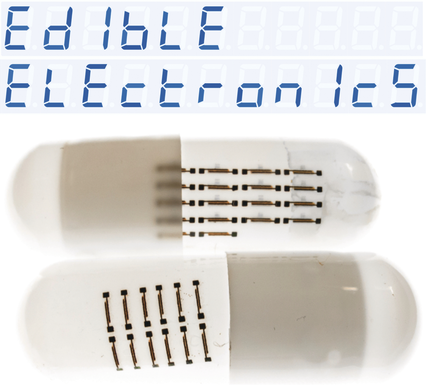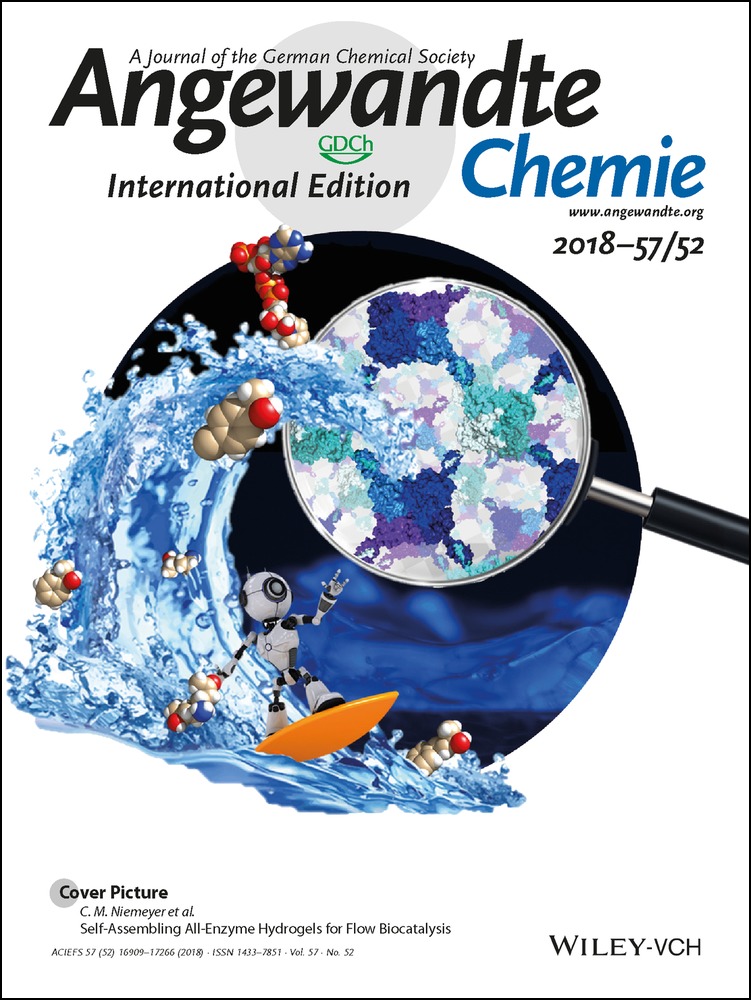Advances in Materials and Structures for Ingestible Electromechanical Medical Devices
Corresponding Author
Prof. Christopher J. Bettinger
Department of Materials Science and Engineering, Department of Biomedical Engineering, Carnegie Mellon University, 5000 Forbes Avenue, Pittsburgh, PA, 15213-3890 USA
Search for more papers by this authorCorresponding Author
Prof. Christopher J. Bettinger
Department of Materials Science and Engineering, Department of Biomedical Engineering, Carnegie Mellon University, 5000 Forbes Avenue, Pittsburgh, PA, 15213-3890 USA
Search for more papers by this authorGraphical Abstract
Ingestible medical devices could significantly improve human health. Recent examples of ingestible biomedical devices include edible cameras, biosensors, and drug delivery systems. This Minireview summarizes recent advances in materials, structures, fabrication techniques, and systems integration, which are relevant to the design of next-generation ingestible biomedical devices. (Picture adapted from Bonacchini et al., Adv. Mat. 2018.)
Abstract
Ingestible biomedical devices that diagnose, prevent, or treat diseases has been a dream of engineers and clinicians for decades. The increasing apparent importance of gut health on overall well-being and the prevalence of many gastrointestinal diseases have renewed focus on this emerging class of medical devices. Several prominent examples of commercially successful ingestible medical devices exist. However, many technical challenges remain before ingestible medical devices can achieve their full clinical potential. This Minireview summarizes recent discoveries in this interdisciplinary topic including novel materials, advanced materials processing techniques, and select examples of integrated ingestible electromechanical systems. After a brief historical perspective, these topics will be reviewed with a dedicated focus on advanced functional materials and fabrication strategies in the context of clinical translation and potential regulatory considerations. Future perspectives, challenges, and opportunities related to ingestible medical devices will also be summarized.
Conflict of interest
The authors declare no conflict of interest.
References
- 1J. T. Farrar, V. K. Zworykin, J. Baum, Science 1957, 126, 975–976.
- 2R. S. Mackay, B. Jacobson, Nature 1957, 179, 1239–1240.
- 3H. B. Sphung, M. von Ardenne, H. B. Sprung, Naturwissenschaften 1958, 45, 154–155.
10.1007/BF00621987 Google Scholar
- 4B. Ross, B. W. Watson, A. W. Kay, Gut 1963, 4, 77–81.
- 5B. Jacobson, R. S. Mackay, Lancet 1957, 269, 1224.
10.1016/S0140-6736(57)91792-0 Google Scholar
- 6S. Kimoto, T. Watanuki, M. Hori, K. Suma, J. Nagumo, A. Ouchi, T. Takahashi, M. Kumano, H. Watanabe, Med. Electron. Biol. Eng. 1964, 2, 85–87.
- 7K. Triantafyllou, C. Kalantzis, A. A. Papadopoulos, P. Apostolopoulos, T. Rokkas, N. Kalantzis, S. D. Ladas, Dig. Liver Dis. 2007, 39, 575–580.
- 8J. Worsøe, L. Fynne, T. Gregersen, V. Schlageter, L. A. Christensen, J. F. Dahlerup, N. J. Rijkhoff, S. Laurberg, K. Krogh, BMC Gastroenterol. 2011, 11, 145.
- 9A. M. Connell, E. N. Rowlands, Gut 1960, 1, 266–272.
- 10P. N. Cutchis, A. F. Hogrefe, J. C. Lesho, Johns Hopkins APL Tech. Dig. 1988, 9, 16–21.
- 11C. Byrne, C. L. Lim, Br. J. Sports Med. 2007, 41, 126–133.
- 12G. Iddan, G. Meron, A. Glukhovsky, P. Swain, Nature 2000, 405, 417.
- 13M. A. Al-Rawhani, J. Beeley, D. R. S. Cumming, Sci. Rep. 2015, 5, 18591.
- 14H. Neumann, L. C. Fry, A. Nägel, M. F. Neurath, Curr. Opin. Gastroenterol. 2014, 30, 463.
- 15J. F. Cryan, T. G. Dinan, Nat. Rev. Neurosci. 2012, 13, 701–712.
- 16T. G. Dinan, J. F. Cryan, Nat. Rev. Gastroenterol. Hepatol. 2017, 14, 69–70.
- 17J. A. Leighton, I. M. Gralnek, S. A. Cohen, E. Toth, D. R. Cave, D. C. Wolf, G. E. Mullin, S. R. Ketover, P. E. Legnani, E. G. Seidman, et al., Clin. Gastroenterol. Hepatol. 2014, 12, 609–615.
- 18Center for Devices and Radiological Health (CDRH), 2001.
- 19G. A. Burdock, I. G. Carabin, Toxicol. Lett. 2004, 150, 3–18.
- 20J. L. Frestedt, in Food Control Biosecurity, Academic Press, San Diego, 2018, pp. 543–565.
- 21Z. Liao, R. Gao, C. Xu, Z.-S. Li, Gastrointest. Endosc. 2010, 71, 280–286.
- 22Y. Wang, G. A. Ameer, B. J. Sheppard, R. Langer, Nat. Biotechnol. 2002, 20, 602–606.
- 23C. L. E. Nijst, J. P. Bruggeman, J. M. Karp, L. Ferreira, A. Zumbuehl, C. J. Bettinger, R. Langer, Biomacromolecules 2007, 8, 3067–3073.
- 24C. J. Bettinger, Macromol. Biosci. 2011, 11, 467–482.
- 25C. Zhu, S. R. Kustra, C. J. Bettinger, Acta Biomater. 2013, 9, 7362–7370.
- 26M. Irimia-Vladu, P. A. Troshin, M. Reisinger, L. Shmygleva, Y. Kanbur, G. Schwabegger, M. Bodea, R. Schwödiauer, A. Mumyatov, J. W. Fergus, et al., Adv. Funct. Mater. 2010, 20, 4069–4076.
- 27C. J. Bettinger, Z. Bao, Adv. Mater. 2010, 22, 651–655.
- 28H. Acar, S. Çınar, M. Thunga, M. R. Kessler, N. Hashemi, R. Montazami, Adv. Funct. Mater. 2014, 24, 4135–4143.
- 29S.-W. Hwang, H. Tao, D.-H. Kim, H. Cheng, J.-K. Song, E. Rill, M. A. Brenckle, B. Panilaitis, S. M. Won, Y.-S. Kim, et al., Science 2012, 337, 1640–1644.
- 30S.-W. Hwang, G. Park, C. Edwards, E. A. Corbin, S.-K. Kang, H. Cheng, J.-K. Song, J.-H. Kim, S. Yu, J. Ng, et al., ACS Nano 2014, 8, 5843–5851.
- 31L. Yin, C. Bozler, D. V. Harburg, F. Omenetto, J. A. Rogers, Appl. Phys. Lett. 2015, 106, 014105.
- 32P. Nadeau, D. El-Damak, D. Glettig, Y. L. Kong, S. Mo, C. Cleveland, L. Booth, N. Roxhed, R. Langer, A. P. Chandrakasan, et al., Nat. Biomed. Eng. 2017, 1, 0022.
- 33H. Hafezi, T. L. Robertson, G. D. Moon, K.-Y. Au-Yeung, M. J. Zdeblick, G. M. Savage, IEEE Trans. Biomed. Eng. 2015, 62, 99–109.
- 34L. Yin, X. Huang, H. Xu, Y. Zhang, J. Lam, J. Cheng, J. A. Rogers, Adv. Mater. 2014, 26, 3879–3884.
- 35X. Jia, C. Wang, C. Zhao, Y. Ge, G. G. Wallace, Adv. Funct. Mater. 2016, 26, 1454–1462.
- 36S. A. Patel, A. D. Hillel, J. Perkins, JAMA Otolaryngol. Neck Surg. 2013, 139, 304–306.
- 37B. Laulicht, G. Traverso, V. Deshpande, R. Langer, J. M. Karp, Proc. Natl. Acad. Sci. USA 2014, 111, 16490–16495.
- 38Y. J. Kim, W. Wu, S.-E. Chun, J. F. Whitacre, C. J. Bettinger, Proc. Natl. Acad. Sci. USA 2013, 110, 20912–20917.
- 39Y. J. Kim, W. Wu, S.-E. Chun, J. F. Whitacre, C. J. Bettinger, Adv. Mater. 2014, 26, 6572–6579.
- 40Y. J. Kim, A. Khetan, W. Wu, S.-E. Chun, V. Viswanathan, J. F. Whitacre, C. J. Bettinger, Adv. Mater. 2016, 28, 3173–3180.
- 41C. Dagdeviren, Z. Li, Z. L. Wang, Annu. Rev. Biomed. Eng. 2017, 19, 85–108.
- 42Y. Chyan, R. Ye, Y. Li, S. P. Singh, C. J. Arnusch, J. M. Tour, ACS Nano 2018, 12, 2176–2183.
- 43G. E. Bonacchini, C. Bossio, F. Greco, V. Mattoli, Y.-H. Kim, G. Lanzani, M. Caironi, Adv. Mater. 2018, 30, 1706091.
- 44M. A. Meitl, Z.-T. Zhu, V. Kumar, K. J. Lee, X. Feng, Y. Y. Huang, I. Adesida, R. G. Nuzzo, J. A. Rogers, Nat. Mater. 2006, 5, 33–38.
- 45J. A. Rogers, M. G. Lagally, R. G. Nuzzo, Nature 2011, 477, 45–53.
- 46H. Wu, V. Sariola, C. Zhu, J. Zhao, M. Sitti, C. J. Bettinger, Adv. Mater. 2015, 27, 3398–3404.
- 47W.-C. Huang, X. C. Ong, I. S. Kwon, C. Gopinath, L. E. Fisher, H. Wu, G. K. Fedder, R. A. Gaunt, C. J. Bettinger, Adv. Funct. Mater. 2018, 28, 1801059.
- 48S. Zhang, A. M. Bellinger, D. L. Glettig, R. Barman, Y.-A. L. Lee, J. Zhu, C. Cleveland, V. A. Montgomery, L. Gu, L. D. Nash, et al., Nat. Mater. 2015, 14, 1065–1071.
- 49A. M. Bellinger, M. Jafari, T. M. Grant, S. Zhang, H. C. Slater, E. A. Wenger, S. Mo, Y.-A. L. Lee, H. Mazdiyasni, L. Kogan, et al., Sci. Transl. Med. 2016, 8, 365ra157.
- 50E. A. Klausner, E. Lavy, M. Friedman, A. Hoffman, J. Controlled Release 2003, 90, 143–162.
- 51T. G. Leong, C. L. Randall, B. R. Benson, N. Bassik, G. M. Stern, D. H. Gracias, Proc. Natl. Acad. Sci. USA 2009, 106, 703–708.
- 52A. Ghosh, C. Yoon, F. Ongaro, S. Scheggi, F. M. Selaru, S. Misra, D. H. Gracias, Front. Mech. Eng. 2017, 3, https://doi.org/10.3389/fmech.2017.00007.
- 53H. Tao, M. A. Brenckle, M. Yang, J. Zhang, M. Liu, S. M. Siebert, R. D. Averitt, M. S. Mannoor, M. C. McAlpine, J. A. Rogers, et al., Adv. Mater. 2012, 24, 1067–1072.
- 54L. Osterberg, T. Blaschke, N. Engl. J. Med. 2005, 353, 487–497.
- 55K. Kalantar-Zadeh, K. J. Berean, N. Ha, A. F. Chrimes, K. Xu, D. Grando, J. Z. Ou, N. Pillai, J. L. Campbell, R. Brkljača, et al., Nat. Electron. 2018, 1, 79–87.
- 56M. Mimee, P. Nadeau, A. Hayward, S. Carim, S. Flanagan, L. Jerger, J. Collins, S. McDonnell, R. Swartwout, R. J. Citorik, et al., Science 2018, 360, 915–918.
- 57A. Craney, T. Hohenauer, Y. Xu, N. K. Navani, Y. Li, J. Nodwell, Nucleic Acids Res. 2007, 35, e 46.
- 58M. Koziolek, M. Grimm, D. Becker, V. Iordanov, H. Zou, J. Shimizu, C. Wanke, G. Garbacz, W. Weitschies, J. Pharm. Sci. 2015, 104, 2855–2863.
- 59J. Shintake, H. Sonar, E. Piskarev, J. Paik, D. Floreano, arXiv.org 2017, 1703.01423.
- 60W. Xie, W. M. Lewis, J. Kaser, C. Ross Welch, P. Li, C. A. Nelson, V. Kothari, B. S. Terry, J. Biomech. Eng. 2017, 139, 081003-10.
- 61J. T. Farrar, C. Berkley, V. K. Zworykin, Science 1960, 131, 1814.
- 62R. S. Mackay, IRE Trans. Med. Electron. 1959, ME-6, 100–105.
- 63R. S. Mackay, Science 1961, 134, 1196–1202.
- 64J. L. Gonzalez-Guillaumin, D. C. Sadowski, K. V. I. S. Kaler, M. P. Mintchev, IEEE Trans. Biomed. Eng. 2007, 54, 2231–2236.
- 65M. Imran, Swallowable Drug Delivery Device and Methods of Drug Delivery, 2016, US9456988B2.
- 66M. Koziolek, M. Grimm, D. Becker, V. Iordanov, H. Zou, J. Shimizu, C. Wanke, G. Garbacz, W. Weitschies, J. Pharm. Sci. 2015, 104, 2855–2863.
- 67D. Becker, J. Zhang, T. Heimbach, R. C. Penland, C. Wanke, J. Shimizu, K. Kulmatycki, AAPS PharmSciTech 2014, 15, 1490–1497.
- 68E. Söderlind, B. Abrahamsson, F. Erlandsson, C. Wanke, V. Iordanov, C. von Corswant, J. Controlled Release 2015, 217, 300–307.
- 69J. M. Maurer, R. C. A. Schellekens, H. M. van Rieke, C. Wanke, V. Iordanov, F. Stellaard, K. D. Wutzke, G. Dijkstra, M. van der Zee, H. J. Woerdenbag, et al., PLOS ONE 2015, 10, e 0129076.
- 70J. Z. Ou, C. K. Yao, A. Rotbart, J. G. Muir, P. R. Gibson, K. Kalantar-zadeh, Trends Biotechnol. 2015, 33, 208–213.





